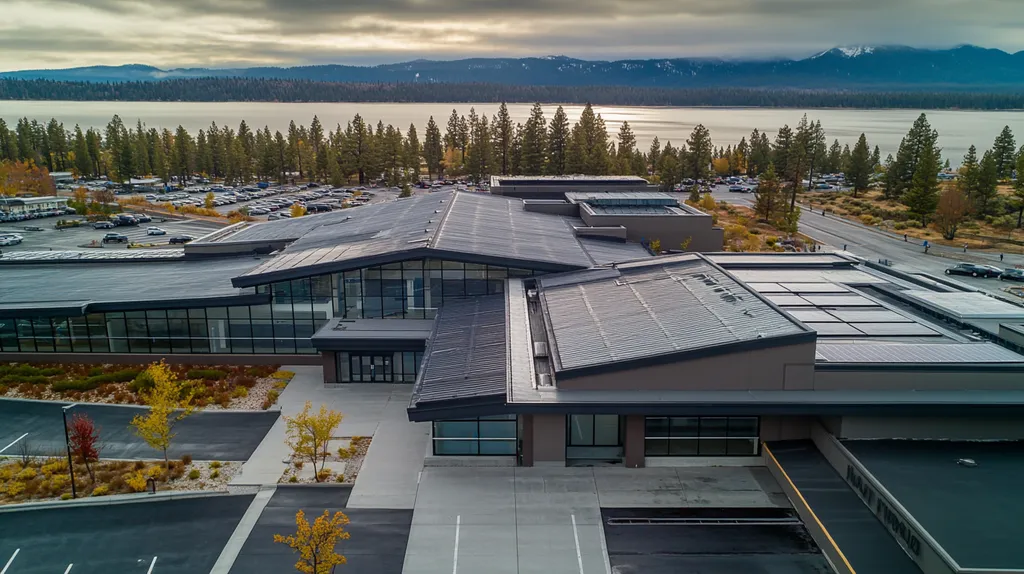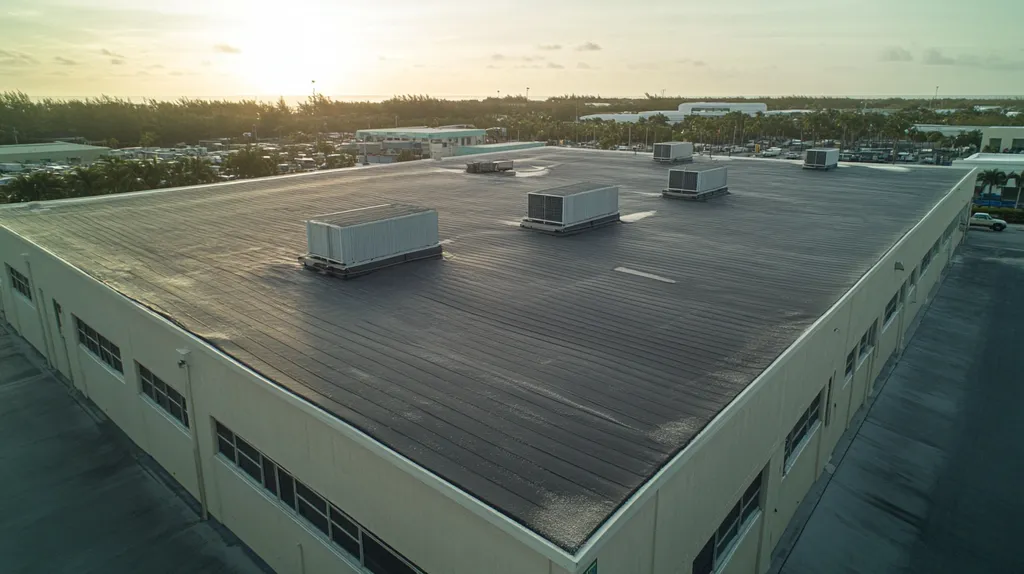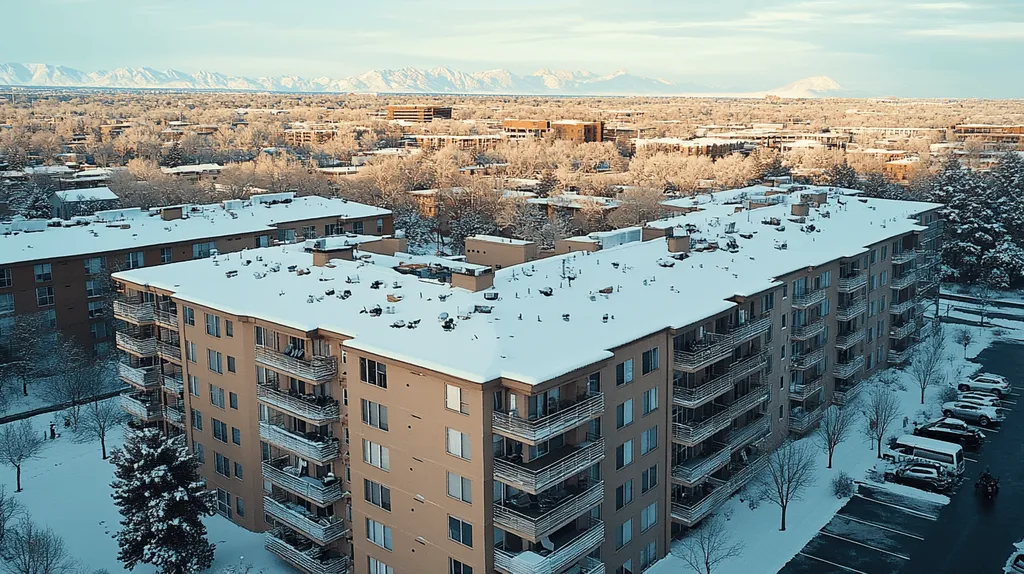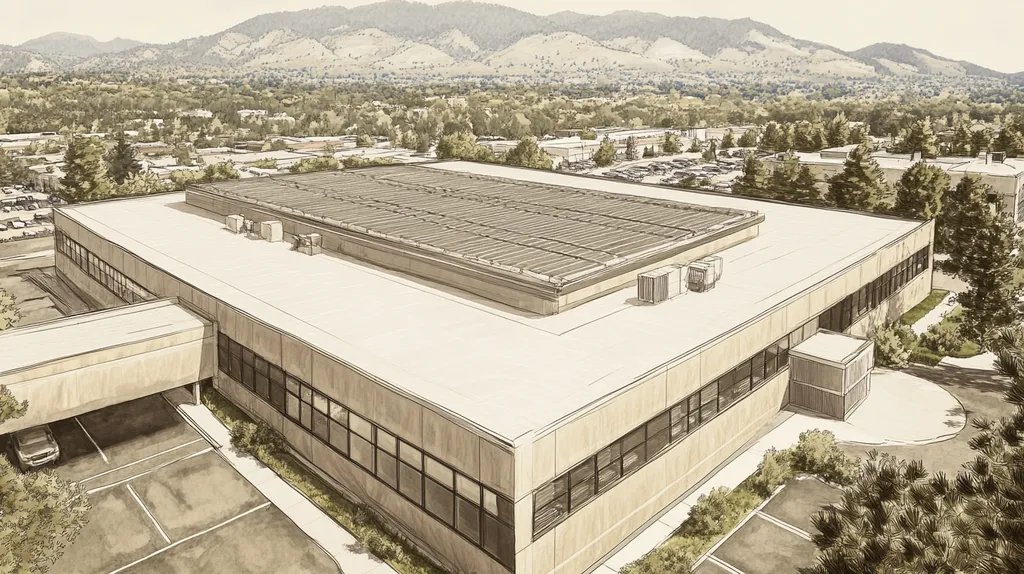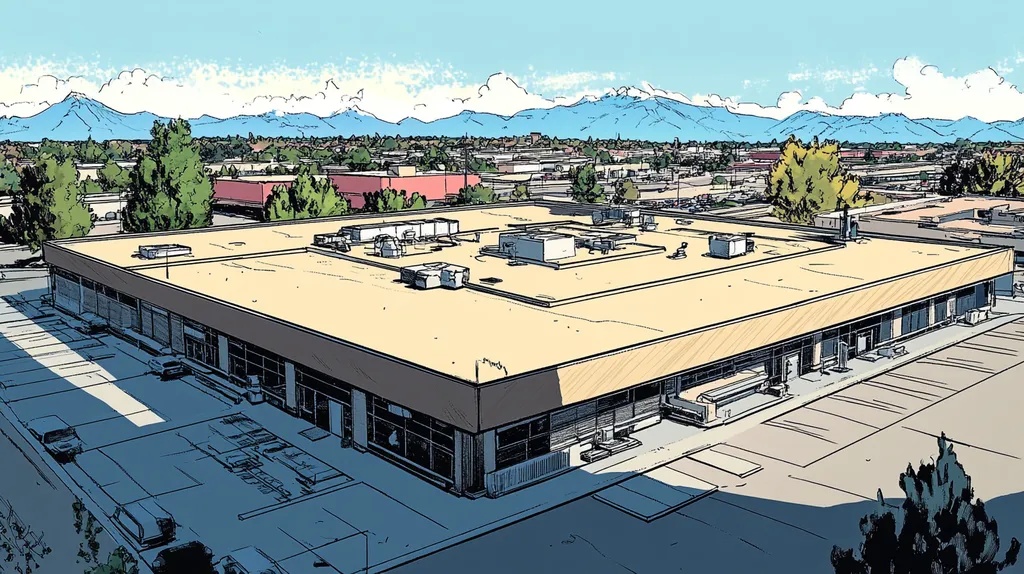Commercial property owners face a mounting crisis when it comes to roof insurance qualifications, with over 40% of claims being denied due to inadequate documentation and misunderstood requirements.
The financial stakes are staggering – a single denied claim can cost businesses upwards of $100,000 in out-of-pocket expenses, threatening their very survival.
This comprehensive guide cuts through common misconceptions about commercial roof insurability, examining critical factors from maintenance requirements to contractor certifications that determine whether a roof qualifies for coverage.
SECTION 1: COMMON MISCONCEPTIONS
Understanding the insurability of a commercial roof is crucial, yet many property owners harbor misconceptions that could lead to serious financial consequences. It’s a common belief that the age of a roof alone dictates whether it can be insured. However, research shows that misunderstandings around roof condition and materials account for about 30% of denied insurance claims in commercial properties. This section unpacks three key misconceptions, shedding light on their implications for insurance coverage and long-term costs.
Age of the Roof and Insurability
A prevalent assumption among property owners is that older roofs are inherently uninsurable. This belief is not entirely accurate. While age plays a role, insurers consider various factors, such as the roof’s overall condition, maintenance history, and the materials used in its construction.
For instance, an older flat roof that has been meticulously maintained may still qualify for competitive insurance terms. In contrast, a newer roof that has not received proper care could face steeper premiums or outright denial of coverage. This highlights the crucial distinction between age and overall condition.
Regular inspections and proactive maintenance can keep an older roof in a condition that meets insurance standards, thereby safeguarding both financial stability and peace of mind. Consequently, property owners should view age as one aspect in a larger evaluation rather than a standalone criterion.
Additionally, some insurance policies may offer incentives for roofs that meet specific material and age conditions. Neglecting these details can lead to unnecessary expenses.
Material Exclusions in Insurance Policies
Another significant misconception lies in the belief that all roofing materials are equally insurable. Many insurance policies contain specific exclusions, which property owners often overlook. Certain roofing materials may not be covered due to safety concerns or a record of poor performance.
For example, materials like thatch or organic shingles may be excluded, exposing property owners to considerable financial risk during a claim. It is essential to research the materials used in roofing and engage in detailed discussions with insurers regarding coverage specifics.
Interestingly, newer roofing materials may offer better insurability compared to traditional options. Understanding these nuances can avoid inflated repair costs and potential claim denials. Failing to comprehend the risks associated with different roofing materials can leave commercial property owners vulnerable, making it vital to consult with experienced roofing professionals.
DIY Repairs and Insurance Coverage
The notion that DIY repairs are acceptable and won’t impact insurance coverage is a misconception that can have serious repercussions. Insurers typically require that repairs be conducted by licensed professionals to maintain coverage validity. Failing to adhere to this guideline can lead to denied claims.
For example, a property owner attempting a DIY repair may inadvertently cause further damage, potentially exceeding the limits of their coverage. Furthermore, if the repair lacks proper documentation or does not meet industry standards, future claims could become complicated and problematic.
Property owners should keep detailed records of all repairs and prioritize hiring qualified professionals to enhance their position during claims. Insurers often provide guidance on selecting certified contractors, which is a crucial step toward ensuring compliance.
Ultimately, overlooking the importance of professional repairs can result in significant financial setbacks. Property owners must emphasize the value of professional services over cost-saving DIY efforts to protect their insurance coverage.
SECTION 2: PRACTICAL IMPLICATIONS
The choice of a commercial roof and its qualifications can have profound implications on maintenance and overall property expenses. Research suggests that inadequately qualified roofing systems can lead to unexpectedly high repair costs, significantly impacting profit margins. For example, a minor leak left unattended can escalate into major structural damage, costing businesses thousands of dollars in repairs. Building owners must grasp these implications to prevent financial turmoil in the future.
Impact on Maintenance and Repair Costs
Investing in regular maintenance for a well-qualified roof can lead to substantial savings over the years. If property owners overlook or misjudge their roof’s selection, they risk incurring frequent and costly repairs. For instance, the annual expense for maintaining a properly qualified roof can be around $1,000 for inspections, whereas an unqualified roof can incur unexpected repair costs exceeding $10,000.
Furthermore, certain roofing materials, like TPO or EPDM, are known for their extraordinary durability. Opting for high-quality materials not only reduces maintenance frequency but also minimizes severity of issues that arise. Business owners should focus on lifecycle costs rather than just initial price tags to make informed roofing choices.
Regular inspections and timely repairs are essential to this process. By neglecting these practices, minor problems have the potential to spiral into major expenses. A proactive maintenance plan can greatly reduce long-term costs and enhance overall roof longevity.
Incorporating a routine inspection budget not only keeps repair costs manageable but also extends the roof’s lifespan, ultimately protecting the organization’s financial health.
Consequences of Uncovered Perils
Failing to acknowledge the risks tied to a poorly qualified roof can result in significant losses. When severe weather strikes, vulnerabilities in roofing can lead to damages that may not be covered by insurance if standards are neglected. Alarmingly, statistics indicate that up to 40% of claims are denied due to improper roof installations.
Moreover, uncovered risks can induce considerable business interruptions. For example, if a roof collapses due to inadequate qualification, it can halt operations, resulting in profit losses. Facilities managers must ensure that roofs meet insurance qualifications to protect against these potentially devastating risks.
Another critical aspect is the impact on stakeholder relationships. Damage from uncovered perils could undermine trust with clients and suppliers, disrupting future business opportunities. To mitigate these risks, building owners should conduct regular assessments that ensure compliance and identify vulnerabilities early.
By proactively addressing potential threats, businesses not only secure insurance coverage but also uphold business continuity in the face of unexpected challenges.
Liability and Business Interruption
Liability concerns regarding roofing can pose substantial hazards to business operations. A roof that fails to meet essential standards increases the likelihood of accidents, resulting in debilitating liability claims. Research highlights that businesses face significantly higher liability premiums when roofs are not properly maintained or qualified.
Additionally, roof failure can instigate lengthy business interruptions, with recovery processes potentially taking weeks or months, leading to massive financial strain. Many companies report revenue reductions of 25% or more during major repair phases.
In these scenarios, property owners must weigh the impacts on their reputations. Delays or safety compromises resulting from roofing issues can erode customer trust. It is crucial for building owners to give priority to roofing qualifications to limit potential liabilities and ensure seamless business operations.
Ultimately, effective roofing qualifications lay the groundwork for not only structural integrity but also the financial stability and reliability of a business. By emphasizing these qualifications, organizations can safeguard against unforeseen challenges and foster a sustainable future.
SECTION 3: COST OF MISINFORMATION
The consequences of overlooking proper qualifications for a commercial roof are significant and often costly. Misinterpreting roofing requirements can lead to uninsured roofs, putting property owners at a serious financial disadvantage. Recent studies reveal that nearly 30% of commercial roofs are inadequately insured, exposing owners to steep losses when crises occur. This section delves into the financial impacts of uninsured roofs, the risks associated with secondary damage and uncovered claims, and the long-term costs linked to maintenance and replacement due to misinformation.
Financial Ramifications of Uninsured Roofs
Inadequate insurance coverage for a commercial roof can result in catastrophic financial burdens. When a roof fails or is damaged during a storm, the property owner may face repair costs that must be covered out-of-pocket. For many small to medium-sized businesses, such sudden expenses can push them to the brink of bankruptcy.
Furthermore, insurance policies often specify coverage for defined risks. If a roof hasn’t been properly evaluated or insured, claims could be denied. This situation typically arises when the insurer finds that the damage isn’t comprehensively covered, resulting in unforeseen expenses for the owner.
For instance, replacing a commercial roof can easily exceed $100,000; without coverage, this responsibility rests entirely on the property owner, drastically affecting their cash flow and future investment potential.
Additionally, the threat of rising premiums is real. Insurers typically increase premiums for properties with a history of uninsured losses. This creates a vicious cycle where insufficient coverage not only leads to greater risks but also escalates overall property costs.
Secondary Damage and Uncovered Claims
The dangers of misinformation extend to secondary damage and uncovered claims, which can spiral into significant financial losses. Issues like water infiltration, mold development, and weaknesses in structure often arise from a compromised roof and inadequate maintenance due to lack of insurance.
For example, a seemingly minor roof leak can result in extensive interior damage, affecting the building’s structure and its contents. If property owners or facility managers are unaware of their roof’s uninsured status, they might skip crucial preventative maintenance, exacerbating the situation and leading to larger claims later.
Uncovered claims can be particularly distressing for property owners who mistakenly believe they are insured. When filing a claim reveals a lack of coverage, it can nullify any chance of receiving reimbursement for related damages. This underscores the necessity for thorough understanding and communication concerning insurance policies and roof conditions.
Therefore, property owners must commit to accurate assessments and transparent communication with their insurance providers to minimize risks and protect against financial losses.
Long-Term Maintenance and Replacement Costs
Misinformation can lead to chronic underinvestment in roofing systems, significantly increasing long-term maintenance and replacement costs. When property owners underestimate the intricacies of their roofs, they frequently fail to allocate sufficient budget for necessary upkeep and repairs.
Research indicates that poorly maintained roofs can face a lifespan reduction of 20% or more. This increase in wear not only calls for more frequent replacements but also elevates costs over time.
For instance, a commercial property that does not allocate funds for regular inspections might experience sudden breakdowns. The resulting emergency repairs can cost three to four times more than routine maintenance interventions.
Moreover, if a roof must be replaced prematurely due to neglect, the financial repercussions can be severe. The property owner may end up paying both for ongoing maintenance and a new roof long before anticipated.
In conclusion, understanding commercial roofing qualifications is essential to mitigating the costly effects of misinformation. By proactively addressing these issues, property owners can realize substantial savings and create a more resilient and sustainable built environment.
SECTION 4: REALITY CHECK
Understanding the ins and outs of insurance coverage for commercial roofs is not just a good practice—it’s essential. Many property owners find themselves blindsided by unexpected expenses due to misunderstandings of policy exclusions and limitations. Alarmingly, reports show that approximately 30% of insurance claims are denied due to insufficient policy comprehension. This section underscores the critical role of routine inspections and vigilant monitoring, as well as the necessity of hiring licensed and certified contractors.
Understanding Policy Exclusions and Limitations
When it comes to commercial roofing insurance, the devil is often in the details, particularly in the fine print of policy exclusions. Many policies may not cover damages resulting from neglect, normal wear and tear, or specific weather events. This lack of awareness leaves building owners at significant financial risk when unexpected damage occurs.
For instance, if a roof suffers damage due to a pre-existing condition that was never addressed, the insurer may deny the claim outright. Therefore, familiarizing oneself with policy specifics is not just beneficial; it’s crucial for effective budgeting and risk management. Property owners should meticulously review their policies, ideally with a savvy insurance agent to navigate the complexities.
Additionally, certain roofing types might require detailed maintenance logs to qualify for claims. Insurers often ask for records that demonstrate routine inspections and necessary repairs. Failing to maintain these crucial documents can complicate the claims process when it’s needed most.
Ultimately, gaining a clear understanding of policy exclusions can proactively protect property owners from financial pitfalls. By aligning maintenance practices with insurance stipulations, building owners can significantly minimize their risks and safeguard their investments.
The Role of Routine Inspections and Monitoring
Routine inspections are not just an optional maintenance step; they are vital to preserving the integrity of a commercial roof. Regular assessments can identify potential issues early, averting costly repairs down the line. Ignoring these inspections can lead to moisture buildup that threatens the entire structure.
Research reveals that properties undergoing regular maintenance save between 10% to 20% in long-term repair costs. Furthermore, insurance providers typically favor properties with documented inspections, which can lead to reduced premiums. This emphasizes how regular monitoring serves not merely as maintenance but also as a strategic cost-saving measure.
Property owners should aim to establish a consistent inspection schedule, ideally every six months. Timely identification and resolution of problems can save substantial sums. Innovative approaches, such as drone inspections, can enhance monitoring efficiency and accuracy.
In conclusion, diligent inspections extend a roof’s lifespan while ensuring alignment with insurance policy requirements. By prioritizing regular assessments, property owners position themselves to navigate claims processes more effectively and protect their assets.
Importance of Licensed and Certified Contractors
The selection of a contractor is a pivotal decision that can either elevate or undermine a roofing project. Engaging licensed and certified contractors is essential to ensure that both installations and repairs meet rigorous industry standards. Though hiring unlicensed contractors may initially appear cost-effective, this choice can lead to subpar workmanship and dire complications during the claims process.
Notably, many insurance policies explicitly state that work must be performed by licensed professionals in order to remain eligible for coverage. Ignoring this requirement can result in denied claims or limited coverage options, jeopardizing the property owner’s investments. Ensuring that qualified individuals oversee the roof is essential for maximizing protection.
Additionally, licensed contractors usually carry their own insurance, creating an added layer of security for property owners. This insurance can cover liabilities arising from accidents, shielding owners from unforeseen financial burdens during the roofing process.
Ultimately, investing in licensed and certified contractors represents a smart choice for property owners. It guarantees not only the quality of workmanship but also adherence to insurance criteria, which provides a safety net when navigating potential claims.
SECTION 5: EVIDENCE-BASED ALTERNATIVES
Property owners are sitting on a ticking time bomb when it comes to their commercial roofs. The choice of an inadequate insurance policy can set the stage for devastating financial consequences, especially in the wake of unforeseen damage. With research indicating that 30% of commercial roofs are under-insured or misclassified, understanding how to select the right policy, implement proactive maintenance, and utilize technology can secure assets and prolong the lifespan of buildings.
Selecting the Right Insurance Policy for Your Roof
Choosing a tailored insurance policy for a commercial roof’s unique needs is not just beneficial—it’s critical. Commercial buildings come in various shapes and materials, each requiring specific coverage to protect against different risks. Without this personalized approach, building owners expose themselves to substantial financial loss from weather-related incidents and structural failures.
Many property owners gravitate toward generic policies that fail to account for critical aspects like roof age and local climate patterns. For instance, a flat roof in a heavy snowfall area demands different coverage from a sloped roof exposed to strong winds. Recognizing these distinctions can vastly improve the chances of a successful claim.
Collaborating with an insurance agent experienced in commercial roofing can provide valuable insights and ensure no detail goes overlooked. This specialized guidance can lead to lower premiums as well as smoother claims processing, ultimately fortifying property owner investments.
Investing time in understanding and selecting the right insurance policy is not merely an administrative task but a strategic move that strengthens the resilience of a commercial property. A well-chosen insurance policy minimizes disputes and reduces long-term costs, paving the way for greater peace of mind.
Implementing Best Practices in Roof Maintenance
Consistent roof maintenance is paramount for prolonging the lifespan of commercial roofing systems. Neglecting regular assessments can allow small issues to snowball into costly repairs or necessitate complete roof replacements. For example, routine inspections can identify leaks early on, preventing substantial damage that could lead to thousands in repair costs.
Best practices advocate for at least semi-annual inspections to assess roof conditions. Facilities managers should diligently examine roofs for signs of wear such as cracked membranes or drainage blockages. Additionally, maintaining open lines of communication with roofing contractors ensures that any immediate concerns are addressed promptly.
Establishing detailed maintenance logs is another effective strategy to extend a roof’s longevity. Keeping a comprehensive record of repairs, inspections, and weather incidents can be invaluable for insurance negotiations and future management decisions. This practice provides a clear historical overview of the roof’s condition over time.
In the long term, a dedicated maintenance strategy minimizes emergency repair costs while enhancing safety. By committing to a proactive maintenance program, property owners create an environment that supports the durability and reliability of their roofing systems. This foundational effort safeguards against sudden financial strains related to roofing failures.
Benefits of Intelligent Rooftop Monitoring Systems
Smart rooftop monitoring systems are transforming how commercial property owners oversee their roofs. These innovative technologies provide real-time insights into various conditions, including temperature, moisture levels, and overall structural integrity. With this data at their fingertips, property owners can quickly address emerging issues before they escalate.
For instance, systems with moisture sensors can alert managers to potential leaks long before they lead to significant damage. By nipping problems in the bud, property owners can avoid costly repairs and ensure occupant safety. Moreover, these systems facilitate informed decision-making through precise data analysis.
Integrating advanced monitoring technology can also strengthen relationships with insurance companies. Claims backed by robust data from monitoring systems improve a property owner’s standing during negotiations. Insurers may respond with more favorable rates or coverage options, recognizing the reduced risks associated with enhanced oversight.
Ultimately, investing in intelligent rooftop monitoring systems yields dual benefits: they improve the health of the roof while enhancing insurance preparedness. This proactive approach aligns with the growing demand for efficiency in property management, securing long-term stability and peace of mind for commercial property owners.
SECTION 6: TEST AND VERIFY
The stakes are high for commercial property owners when it comes to roof maintenance. A neglected roof can lead to some of the most significant unexpected repair costs and potentially jeopardize insurance claims. Research indicates that a shocking number of minor roof issues can escalate into serious problems if left unaddressed. This section will shine a light on the critical importance of regular inspections, verifying contractor credentials, and routinely updating insurance policies to ensure optimal coverage.
Conducting Regular Roof Inspections
Proactive roof inspections are vital for catching problems before they spiral out of control. Facilities managers should prioritize conducting inspections at least twice a year, ideally during transitional seasons like spring and fall. These inspections allow for the timely identification of issues such as leaks, membrane deterioration, or drainage complications.
A survey conducted in 2021 revealed that 35% of commercial roofs failed prematurely due to neglecting basic maintenance. Consistent inspections not only help extend a roof’s lifespan but also support compliance with insurance requirements, as many insurers mandate documented inspections to approve claims.
Additionally, inspections should be performed after severe weather events like storms or heavy winds. These conditions can create unseen damage that may not be evident until significant water infiltration occurs. Prompt attention to these issues can save property owners thousands in repair costs in the long run.
Implementing a structured inspection regimen, complete with detailed reporting, ensures that all potential problems are identified and addressed early. This proactive approach positions the property owner favorably in discussions with insurance providers, demonstrating responsibility and diligence in managing risks.
Verifying Contractor Qualifications and Certifications
Selecting the right roofing contractor is crucial for ensuring the longevity and effectiveness of a commercial roof. Not all contractors possess the same expertise, making it essential for property owners to perform due diligence. Essential steps should include verifying licenses, insurance, and affiliations with reputable industry organizations.
The National Roofing Contractors Association emphasizes the importance of hiring certified contractors who have completed rigorous training and adhere to industry standards. This commitment can significantly enhance the quality of work and improve the eligibility for insurance coverage.
A contractor with recognized certifications typically demonstrates a solid adherence to best practices and safety protocols. This can lower a property’s risk profile and lead to favorable coverage options and rates.
Moreover, property owners should review contractors’ past projects and client testimonials to gauge their reliability and performance. By ensuring their chosen contractors are well-qualified, property owners substantially decrease the likelihood of incurring roof-related claims or losses.
Reviewing and Updating Insurance Policies Regularly
Insurance policies should be viewed as dynamic agreements that need regular attention. Conducting annual reviews of coverage options is essential, especially after any significant roofing work or upgrades. Failure to do so can leave property owners underinsured or exposed to additional risks.
Many property owners overlook the implications of outdated policies, resulting in inadequate coverage that threatens their financial security after a claim. Reports show that approximately 30% of commercial properties operate with insufficient insurance, putting them at great risk when damages occur.
As new roofing technologies and materials become available, remaining informed about how these advancements affect insurance coverage is crucial. Collaborating with an insurance advisor who specializes in commercial roofing can yield tailored recommendations to meet specific needs.
Annual policy reviews can unveil opportunities for cost savings or enhancements in coverage. By proactively managing their insurance landscape, property owners strengthen their risk mitigation strategy, ensuring their coverage reflects their real-world conditions and challenges.
The Bottom Line
The landscape of commercial roof insurance is shifting dramatically, with over $2.1 billion in denied claims annually due to qualification issues.
Property owners who fail to understand and meet insurance requirements face devastating financial consequences, often exceeding $100,000 per incident.
The evidence is clear: successful roof insurance outcomes depend on three critical factors – regular professional inspections, proper documentation, and certified contractor partnerships.
Smart monitoring systems and proactive maintenance programs are no longer optional – they’re essential tools for protecting commercial roofing investments and ensuring continued insurability.
By implementing comprehensive qualification protocols and staying current with policy requirements, property owners can safeguard their assets while potentially reducing premiums by 15-30%.
FREQUENTLY ASKED QUESTIONS
Q. Does the age of a commercial roof determine its insurability?
A. Age alone doesn’t dictate insurance qualifications; overall condition and maintenance play crucial roles. A well-maintained older roof might still qualify for competitive insurance terms, while a neglected newer roof could face denial or higher premiums.
Q. How does an unqualified industrial roof affect maintenance costs?
A. An inadequately qualified roof can lead to significantly higher repair costs. Regular maintenance for a qualified roof may cost around $1,000 annually, whereas an unqualified one could incur unexpected expenses exceeding $10,000 due to neglect.
Q. What are the financial impacts of an uninsured commercial roof?
A. Uninsured roofs can lead to catastrophic financial burdens. If damage occurs, property owners may face steep repair costs out-of-pocket, which could push many businesses into bankruptcy without coverage to shield them from the financial strain.
Q. How can routine inspections help with commercial roof insurance?
A. Regular inspections detect issues early, preventing costly repairs and ensuring compliance with insurance policies. Insurers often favor properties with documented inspections, which can lower premiums and support more favorable claims processing when issues arise.
Q. How do policy exclusions impact commercial roof insurance claims?
A. Many property owners are unaware of policy exclusions, resulting in denied claims. Damage resulting from neglect or pre-existing conditions often isn’t covered, highlighting the importance of understanding specific policy details to avoid financial pitfalls.
Q. What best practices can extend the life of a commercial roof?
A. Best practices include conducting semi-annual inspections, maintaining detailed logs, and addressing minor issues promptly. This proactive approach minimizes emergency repairs and enhances roof durability, ultimately safeguarding financial resources and prolonging roof lifespan.
Q. How can technology benefit commercial roof management?
A. Intelligent rooftop monitoring systems provide real-time insights into roof conditions, helping detect potential issues early. These technologies enhance property management efficiency, improve insurance preparedness, and help secure better coverage and rates by demonstrating risk management capabilities.

